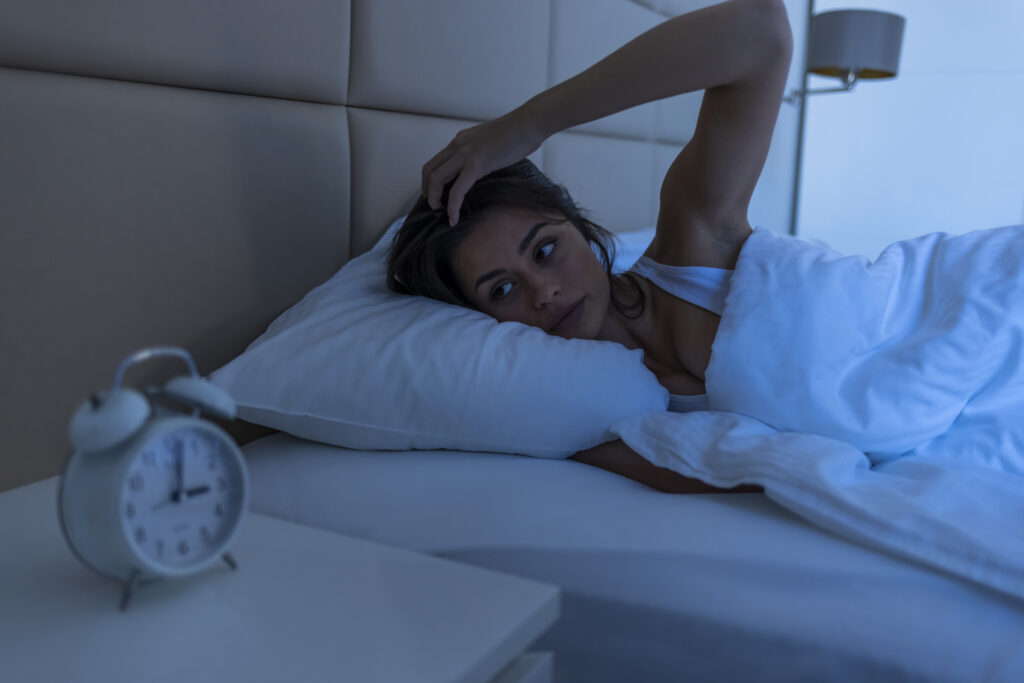What Are Sleep-Wake Disorders
Sleep-wake disorders broadly cover 10 disorders or disorder groups (listed below) and result in issues with the quality of sleep that present with a myriad of symptoms that ultimately lead to dissatisfaction with life due to impairments of social and occupational function. The disorders are:
Insomnia disorder
- Hypersomnolence Disorder
- Narcolepsy: falling asleep at random intervals
- Breathing Related Sleep Disorders (sleep apneas)
- Circadian Rhythm Sleep Disorders
- Non-Rapid Eye Movement Sleep Arousal Disorders
- Nightmare Disorder
- Rapid Eye Movement Sleep Behavior Disorder
- Restless Legs Syndrome
- Substance/medication-induced Sleep Disorder

Common Symptoms
Insomnia
The simplest way to categorize insomnia is that one feels “tired but wired.” According to the Diagnostic and Statistical Manual V-TR (DSM-V-TR), the predominant complaint is that you can’t sleep even when you’re sleepy and, most importantly, this causes “significant distress or impairment in social, occupational, and other important areas of functioning.”
Sleep specialists see this more broadly as a disruption in your sleep of more than 30 minutes a night for over a month, resulting in either fatigue or malaise and/or daytime sleepiness. And it is followed by any of the following:
- impairment in attention, concentration, memory
- dysfunction in social or vocational performance
- mood disturbance or irritability
- dips in motivation and energy
- an increase in mistakes
- headaches and G.I. symptoms
Breathing Related Sleep Disorders (sleep apneas)
These are often referred to as sleep apneas and are the result of an obstructed airflow. These can last for 10 seconds or more and are often accompanied by snoring, snorting/gasping, or pauses in breathing during the course of sleep. The result is incomplete sleep that presents as daytime sleepiness akin to insomnia. Sleep apnea is a very common sleep disorder, with occurrences of up to 15% of adults and 20% of older adults. It also coincides with obesity. However, it can begin in childhood and increase as one ages, which could lead to health issues like obesity, thus creating a cycle. It is more common in males and, according the DSM-V-TR is “approximately twice as high among first-degree relatives of probands with obstructive sleep apnea as compared with members of control families.”
Circadian Rhythm Sleep-Wake Disorders
This pattern of sleep disruption occurs in the times in which someone falls asleep, which are out of sync with the person’s environment or social setting. According to the DSM-V-TR, this could be a delay of two hours when one wants to sleep or an awakening of two hours before one wants to wake up, which results in insomnia or excessive sleepiness. This disruption can also present as frequent arousals throughout the night. The DSM-V-TR suggests that it persists for three months; however, sleep specialists suggest that one month is a long enough duration to seek treatment.
Comorbidities
Sleep disorders are frequently diagnosed alongside anxiety, depression, and substance use disorder. These disorders can manifest as cognitive issues. The prevalence of insomnia in our population is estimated to be at 30-35% for acute insomnia and 10-15% for chronic insomnia. It is tied to higher instances of hypertension, obesity, diabetes, cardiovascular disease, Alzheiumer’s and Dementia.
Nearly 60% of those with sleep apnea have hypertension, and it coincides with obesity the correlation should be confused with causation.
Disturbed sleep is attributed with greater severity of mental illnesses, including substance use disorder, and higher risks for suicide as well as greater instances of relapse and lower completion rates for therapy.
Types of Treatment
There are various medications that can be prescribed for sleep disorders; however, the cognitive behavioral approach has been proven to last longer while ensuring higher quality of sleep found in the last stage of sleep, Rapid Eye Movement (REM). Studies show that quality REM may improve emotional memory, cognitive processing, fear responses, and the reward sensors for high caloric foods.
The cognitive behavioral approach is called Cognitive Behavioral Therapy for Insomnia (CBTi). It is a five-step approach that includes sleep restriction therapy, sleep hygiene, stimulus control, cognitive restructuring, and relaxation therapies. Breath-related sleep disorders, often referred to as sleep apnea, typically require the use of a device called a Controlled Positive Airway Pressure (CPAP) machine, which can be difficult at first to use. CBTi has been proven to be helpful for the adjustment period of using the machine.
When to Seek Treatment
If the problem has persisted for over a month and/or you have already seen a doctor, conducted a polysomnography (sleep study), and/or are looking for behavioral approaches to improve the quality of your sleep.
What Can I Do Before My First Session
After speaking with our therapist, you will fill out a few questionnaires to help with the assessment process, which your therapist will use this to dive deeper into how we can help you. If you’re interested in learning more about sleep and behavioral sleep medicine, check out these resources:
- Podcast: Matthew Walker, PhD, discusses why we sleep
- Podcast: Matthew Walker, PhD, discusses how CBTi works
Website on all things sleep, from definitions on disorders, products to help with sleep, and articles on sleep.



